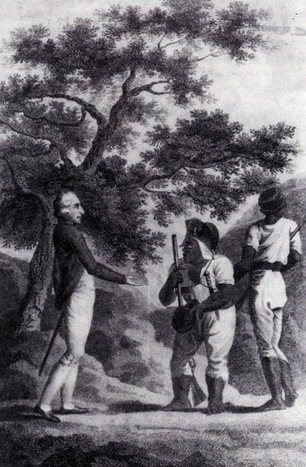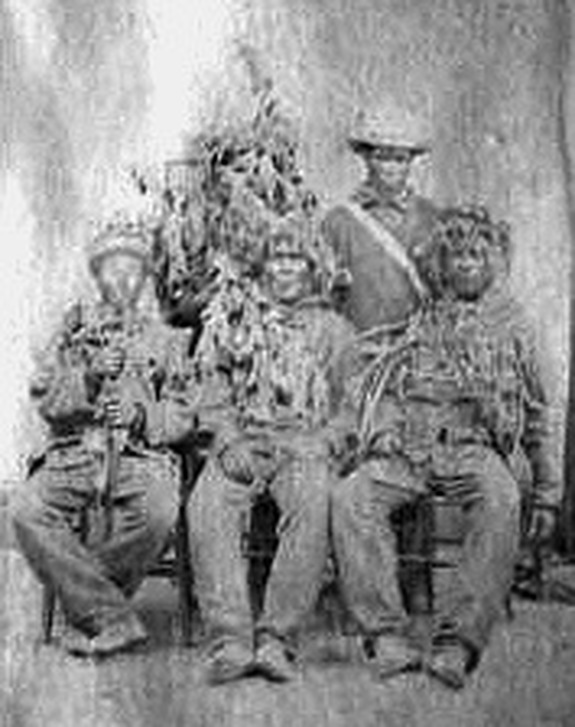New York Tribune, October ?, 1898.
THE JAMAICA MAROONS.
THEIR PECULIAR STATUS UNDER AN ANCIENT TREATY.
A Race of Mixed Negro and Spanish Blood — The Hard Tussle They Gave the English.
THEIR PECULIAR STATUS UNDER AN ANCIENT TREATY.
A Race of Mixed Negro and Spanish Blood — The Hard Tussle They Gave the English.
The Maroons of the Island of Jamaica, who have been making themselves so troublesome to the Colonial Government of late, are a strange and remarkable people in many ways. In the first place, ethnologically they are the only class or caste extant in whose veins flows the blood of the aboriginal race which gave its name. Xaymaca ("Land of Streams and Woods") to the Island. Secondly, they are the only known descendants of the few negro slaves— not more than fifteen hundred—whom the Spanish settlers left in the island when it was seized by the English, under Penn and Venables in 1655.
But this mixed origin, with the probability of a trace of Spanish blood, is not all that makes the Maroons remarkable. Their history during the last two hundred and forty years is unlike that of any other people in the British West Indies, and their legal status is probably unique in this hemisphere.
This peculiar legal status is just what has brought about the trouble between Mr. Salmon, the statutory freeholder of the land under dispute in St. Mary's Parish, on one side and on the other side a band of Maroons, who, like their brethren in other Maroon settlements, are and know themselves to be military tenants of the British crown in virtue sf a treaty ratified and signed just 100 years ago. The dusky disturbers of her Britannic majesty's peace may never have heard of feudal tenure, of fief, or of sub-infeudation, but in all Essentials their relation to Queen Victoria is identical with the relation of William the Conqueror's barons to that "starkman."
ORIGIN OF THE NAME.
It came about very simply. From the time when, on the expulsion of the Spaniards in 1055, the Spanish-negro slaves took to the woods, mixed with the scattered remnant of the aborigines, and made the hunting of wild hogs their chief occupation, until the year 1738, these "Cimarrones" (wild men) had been a terror and. a nuisance to the English settlers. Many laws had been enacted especially for their repression. Packs of hounds were to be maintained by every vestry to hunt the Maroons, as they had already begun to be called by an English corruption of their Spanish name.
Between 1730 and 1738 one Cudjoe earned lasting fame by the audacity and cunning with which he led his Maroons in their characteristic methods of bush fighting. The name of Cudjoe has been preserved to this day in the legend which makes the hollow trunk of a certain gigantic cotton tree near Spanish Town Cudjoe's council chamber. At last the Government of the island, acting for George II, weary of perpetual murder and robbery on the one hand and of laborious repressive operations on the other, sent two commissioners in the King's name to the free and unsubdued, if defeated, Maroons. These Commissioners concluded with Captains Cudjoe, Accompong, Johnny, Cuffee and Quaco, chiefs of the Maroons, a treaty, by the terms of which the latter were to have in perpetuity, free of taxation, to themselves and their heirs, certain lands specified. In return for these emoluments and privileges the Maroons were not only to keep the peace toward King George II, his successors and their lieges, but also were to "kill, suppress or destroy" all rebels against the British crown in Jamaica and invaders of that dominion. This was how the Maroon barons swore fealty in 1738, affixing their marks to the instrument as intelligently, no doubt, and as intelligibly as any of their predecessors did at Runnymede.
A FORMER REBELLION.
But if, as some of the recent dispatches from Jamaica have reported, the St. Mary's Maroons boasted to Governor Hemming that their race had never broken the treaty of 1738, they spoke without adequate warrant of history. It may be that that particular settlement or sept have never betrayed their ancestral pact, but other Maroons certainly rebelled in 1795. This rising was provoked by the seizure, imprisonment and whipping of a Maroon in Trelawney Parish who had stolen a pig. It was not the seizure, nor the imprisonment, nor even the mere whipping that the Maroon complained of, but the shame of being whipped by a common negro in the presence of common negro prisoners. Not until several regiments of British troops had been disastrously engaged, losing many of their men in repeated ambuscades, did the Government appreciate the necessity of entirely different tactics in dealing with the Maroon rebels. Bloodhounds were imported from Cuba to hunt the wild men to their lairs, and these, once tracked, were either killed or deported to Nova Scotia, where their descendants seem to have lost their race identity.
From 1795 until this year—over a century—the remaining Maroons in Jamaica have faithfully kept their pact and the representatives in Jamaica of George ll's heirs have observed their side of the contract. In the negro rising during the last decade of slavery in Jamaica, the Maroons did valuable service in "killing, suppressing and destroying." Thirty years later, in 1865, there was a less really formidable rising of negroes in one locality, but which, somehow, seems to have occasioned more commotion among the representatives of British power in Jamaica.
On this occasion—the present writer speaks from personal recollection—the mere name of Maroon seemed to send a thrill of terror through all those negroes, who, if only by the circumstance of inhabiting the disturbed district, were liable to suspicion of complicity in the Morant Bay riots. None of the rioters nor any of their sympathizers ever made any pretense of armed resistance when the military forces came on the scene. While from the soldiers they could at least run to the bush and be hidden, from the Maroons they had good reason to believe they could no more escape than from "de Lard Garramighty."
THEIR MANNER OF FIGHTING.
Led by Colonel Alexander Gordon Fyfe, a retired officer of the 92nd (Gordon) Highlanders, to whom they were devotedly attached, the Maroons swarmed into the Parish of St. Thomas in the east and all over it. Their weapons were not of the most modern pattern, but their knack of wreathing themselves from head to foot in club moss and broad leaved boughs, and their uncanny power of lying motionless for hours on the watch to "kill, suppress or destroy" a skulking suspect, very soon made the scattered negroes feel that the provost marshal's own compound would be just as safe as the bush and much less trying to the nerves. So it was that a detachment of Maroons had the honor of capturing and bringing to the halter Paul Boyle [Bogle] himself, the actual ringleader of the Morant Bay massacre.
When quiet was fully restored the Maroons, with Colonel Fyfe at their head, entered Kingston in triumph. They marched in column, under arches erected by a loyal and grateful community. They carried their deadly stalking guns, and were wreathed in their strange panoply of foliage. Then they sat down to a banquet, and, finally, a specially honored few of them were grouped and photographed with Colonel Fyfe.
Living apart from the other inhabitants of the island, next to nothing was known in those days of the Maroons, their language, their religion or their customs. In appearance, speaking from childish impressions of that day when they entered Kingston in triumph, most of them were disappointingly like other negroes, except as to their remarkably free and Independent carriage and general air. Here and there one found in the crowd of conscious heroes about the steps and corridors of the courthouse a Maroon face with the black skin of the negro, but a high bridged nose and clean cut mouth; still, these evidences of non negro blood were rare enough to be commented upon by the writer's elders and so impressed upon his memory. If their language was notably different from the "Bungo talk" of the bush negroes, he never knew it. Certainly, Colonel Fyfe could make himself very well understood by them, and he never boasted of the power as implying any rare linguistic acquirement. As to their religion, it was, so far as common report could be trusted, some vague form of "obeah" or "voodoo," which, however, never seemed to make itself objectionable to outsiders.
In the earlier part of the present century, when the anti-slavery agitation attracted attention to Jamaica, several writers found it worth their while to do some little exploring beyond the beaten paths of the island, and one or two visited Accompong Town and other Maroon settlements. These investigators reported a condition of almost complete but contented savagery. The Maroons, they said, held their women in low estimation and practiced polygamy. This much is more than the average inhabitant of Jamaica at the present day can say of his own personal knowledge. Anything you please may be reported of the Maroons—under the breath, if the speaker is a common Jamaica negro.


